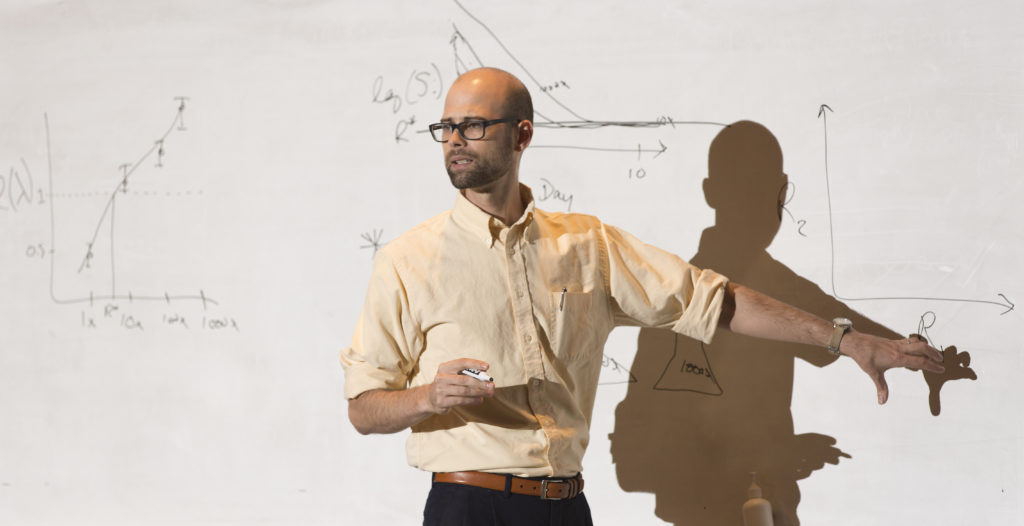What if public health officials had a way to forecast pandemics the way meteorologists forecast the weather?
An interdisciplinary team of scientists with the University of Georgia Center for the Ecology of Infectious Diseases has been awarded a $1 million grant from the National Science Foundation to find a way to do exactly that.
The researchers, led by Regents’ Professor John Drake of the Odum School of Ecology, will use the grant to build systems for infectious disease intelligence that could predict—and ultimately help prevent—novel pandemics like COVID-19.
The goal of the project is to enable public health authorities and other decision-makers to understand in real time where and how spillover—when a disease jumps from wildlife or livestock to humans—may occur, how an outbreak begins to spread and how information can be used to encourage different groups of people to adopt behaviors to keep them and their communities safe.
“I have studied the dynamics of infectious diseases for over 15 years, and I believe that infectious disease models can be developed for real-time interpretation of disease spread anywhere on the planet,” said Drake, who is director of the CEID. “I am inspired by the success of atmospheric models for weather prediction, which have become increasingly sophisticated over the past seventy years. We need the same for infectious diseases. This grant will help us realize infectious disease technologies and methodologies that don’t yet exist.”
The team, which includes several faculty members from UGA as well as researchers from the University of Michigan and the Cary Institute of Ecosystem Studies, has 18 months to prove that their technological innovations can help global industries, governments, nonprofits and societies handle the next infectious disease spillover event or outbreak.
The researchers will follow an approach pioneered to solve complex engineering problems, collaborating on six demonstration projects that are based upon their core expertise. Each project will be modeled on highly pathogenic avian influenza (HPAI), but lessons learned are expected to be transferable to other pathogens, including those emerging diseases that have yet to be identified.
“Highly pathogenic flu is an ideal pathogen to model,” said team member Pejman Rohani, Regents’ Professor in the Odum School and the College of Veterinary Medicine department of infectious diseases. “Like SARS-CoV-2, HPAI is a highly transmissible respiratory virus, and it has a similar pathology. Although our attention is still on COVID-19, a pandemic created by the spillover of HPAI remains an ever-present concern among epidemiologists and public health officials. Much of what we have learned during COVID-19—how people have behaved, the effectiveness of non-pharmaceutical interventions such as wearing a facemask, vaccine hesitancy, and the biology of pathogen transmission—can be directly applied to HPAI.”
The demonstration projects will target different aspects and stages of spillover events, outbreaks, and control efforts. They include developing artificial intelligence platforms that can predict how the environmental interactions between humans and wild animals lead to the transmission of pathogens that cause infectious disease outbreaks, surveys to capture how different human populations are influenced by disease prevention and vaccine acceptance messaging, determining the underlying processes that impact HPAI dynamics and determining which HPAI viruses have pandemic potential through the study of molecular virology and immunology.
Individual demonstration projects are designed so that the outputs of each one feed into the others; the resulting synthesis of information will be much more robust than that of any one project on its own.
This approach has not previously been used in infectious disease modeling, said Glen Nowak, co-director of the Grady College Center for Health and Risk Communication.
“When the COVID-19 pandemic began to spread throughout the globe and the United States, many organizations quickly conducted surveys and polls to learn more about what people were thinking and doing when it came to reducing the spread of the virus and preventing serious illness,” he said. “Traditionally, very little of that information has been used to inform infectious disease models and forecasts, even though human beliefs and behaviors greatly affect how severe and how long a pandemic will last. I am excited about this project because the information not only can inform public health messages, but it can help us identify the beliefs and behaviors that should be public health communication priorities.”
Drake and his colleagues must submit the results of their research by January 2024. Within the next two years, the National Science Foundation is expected to publish a call for Phase II grant proposals to develop a Center for Pandemic Prediction and Prevention. A Center of this magnitude could propel the University of Georgia into a global leader in Infectious Disease Intelligence research and forecasting.
Along with Drake, Rohani and Nowak, the grant’s co-investigators are Justin Bahl of the UGA Colleges of Public Health and Veterinary Medicine, Bogdan Epureanu of the University of Michigan School of Engineering, and Barbara Han of the Cary Institute of Ecosystem Studies.
“I have extensively worked with all of these scientists who have different professional backgrounds and experiences,” said Drake. “I am excited about the advances that we are going to add to the burgeoning field of infectious disease intelligence.”











